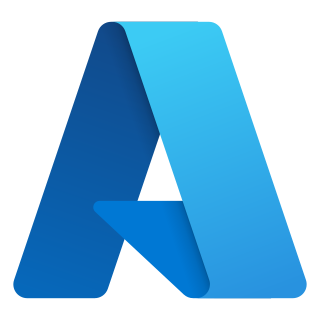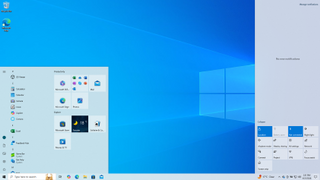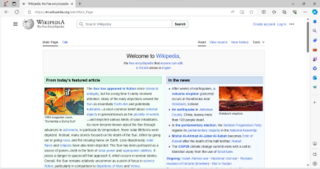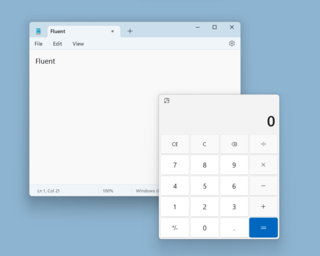
Paint is a simple raster graphics editor that has been included with all versions of Microsoft Windows. The program opens, modifies and saves image files in Windows bitmap (BMP), JPEG, GIF, PNG, and single-page TIFF formats. The program can be in color mode or two-color black-and-white, but there is no grayscale mode. For its simplicity and wide availability, it rapidly became one of the most used Windows applications, introducing many to painting on a computer for the first time.
Microsoft engineering groups are the operating divisions of Microsoft. Starting in April 2002, Microsoft organised itself into seven groups, each an independent financial entity. In September 2005, Microsoft announced a reorganization of its then seven groups into three. In July 2013, Microsoft announced another reorganization into five engineering groups and six corporate affairs groups. A year later, in June 2015, Microsoft reformed into three engineering groups. In September 2016, a new group was created to focus on artificial intelligence and research. On March 29, 2018, a new structure merged all of these into three.

Microsoft Azure, often referred to as Azure, is a cloud computing platform run by Microsoft. It offers access, management, and the development of applications and services through global data centers. It also provides a range of capabilities, including software as a service (SaaS), platform as a service (PaaS), and infrastructure as a service (IaaS). Microsoft Azure supports many programming languages, tools, and frameworks, including Microsoft-specific and third-party software and systems.

Minecraft is a 2011 sandbox game developed by Mojang Studios and originally released in 2009. The game was created by Markus "Notch" Persson in the Java programming language. Following several early private testing versions, it was first made public in May 2009 before being fully released in November 2011, with Notch stepping down and Jens "Jeb" Bergensten taking over development. Minecraft has become the best-selling video game in history, with over 300 million copies sold and nearly 140 million monthly active players as of 2023. It has been ported to several platforms.

Windows To Go is a feature in Windows 8 Enterprise, Windows 8.1 Enterprise, Windows 10 Education and Windows 10 Enterprise versions prior to the May 2020 update, that allows the system to boot and run from certain USB mass storage devices such as USB flash drives and external hard disk drives which have been certified by Microsoft as compatible. It is a fully manageable corporate Windows environment. The development of Windows To Go was discontinued by Microsoft in 2019, and is no longer available in Windows 10 as of the May 2020 update.

Joe Belfiore is an American business executive who has held various roles at Microsoft since August 1990, mostly in the field of user experience. He is currently the Corporate Vice President in the Experiences and Devices division of Microsoft. A frequent speaker, Belfiore has appeared at many Microsoft conferences, often giving demos on stage. He has also hosted a TED Talk. Belfiore intends to retire from Microsoft early summer 2023.

Windows 10 is a major release of Microsoft's Windows NT operating system. It is the direct successor to Windows 8.1, which was released nearly two years earlier. It was released to manufacturing on July 15, 2015, and later to retail on July 29, 2015. Windows 10 was made available for download via MSDN and TechNet, as a free upgrade for retail copies of Windows 8 and Windows 8.1 users via the Microsoft Store, and to Windows 7 users via Windows Update. Windows 10 receives new builds on an ongoing basis, which are available at no additional cost to users, in addition to additional test builds of Windows 10, which are available to Windows Insiders. Devices in enterprise environments can receive these updates at a slower pace, or use long-term support milestones that only receive critical updates, such as security patches, over their ten-year lifespan of extended support. In June 2021, Microsoft announced that support for Windows 10 editions which are not in the Long-Term Servicing Channel (LTSC) will end on October 14, 2025.

Microsoft Edge is a proprietary, AI-powered cross-platform web browser created by Microsoft. Released in 2015 as part of Windows 10 and Xbox One, it was initially built with Microsoft's own proprietary browser engine, EdgeHTML, and their Chakra JavaScript engine. Later on, it was ported to Android and iOS as a fork of Google's Chromium open-source project. In late 2018, Microsoft announced it would completely rebuild Edge as a Chromium-based browser with Blink and V8 engines, which allowed the browser to be ported to macOS. The new Edge was publicly released in January 2020, and on Xbox platforms in 2021. Microsoft has since terminated security support for the original browser, and Edge is also available on older Windows versions, as well as Linux.

Windows Mixed Reality (WMR) is a discontinued platform by Microsoft which provides augmented reality and virtual reality experiences with compatible head-mounted displays.

Microsoft HoloLens is an augmented reality (AR)/mixed reality (MR) headset developed and manufactured by Microsoft. HoloLens runs the Windows Mixed Reality platform under the Windows 10 operating system. Some of the positional tracking technology used in HoloLens can trace its lineage to the Microsoft Kinect, an accessory for Microsoft's Xbox 360 and Xbox One game consoles that was introduced in 2010.
Windows 10 has several editions, all with varying feature sets, use cases, or intended devices. Certain editions are distributed only on devices directly from an original equipment manufacturer (OEM), while editions such as Enterprise and Education are only available through volume licensing channels. Microsoft also makes editions of Windows 10 available to device manufacturers for use on specific classes of devices, including IoT devices and previously marketed Windows 10 Mobile for smartphones.
Windows 10 is a major release of the Windows NT operating system developed by Microsoft. Microsoft described Windows 10 as an "operating system as a service" that would receive ongoing updates to its features and functionality, augmented with the ability for enterprise environments to receive non-critical updates at a slower pace or use long-term support milestones that will only receive critical updates, such as security patches, over their five-year lifespan of mainstream support. It was released in July 2015.
A Minecraft mod is a mod that changes aspects of the sandbox game Minecraft. Minecraft mods can add additional content to the game, make tweaks to specific features, and optimize performance. Thousands of mods for the game have been created, with some mods even generating an income for their authors. While Mojang Studios does not provide an API for modding, community tools exist to help developers create and distribute mods. The popularity of Minecraft mods has been credited for helping Minecraft become one of the best-selling video games of all time.

Paint 3D is a raster graphics and 3D computer graphics application which is a refresh of Microsoft Paint. It is one of several 3D modeling and printing applications introduced or improved with the Windows 10 Creators Update, including View 3D, Windows Mixed Reality, Holograms, along with the CAD programs 3D Builder and 2D Builder.

3D Viewer is a 3D computer graphics viewer and augmented reality application that was first included in Windows 10 1703. It supports the .fbx, .3mf, .obj, and .stl and many more file formats listed in features section.

Fluent Design System, officially unveiled as Microsoft Fluent Design System, is a design language developed in 2017 by Microsoft. Fluent Design is a revamp of Microsoft Design Language that includes guidelines for the designs and interactions used within software designed for all Windows 10 and Windows 11 devices and platforms. The system is based on five key components: light, depth, motion, material, and scale. The new design language includes more prominent use of motion, depth, and translucency effects.
Microsoft, a technology company historically known for its opposition to the open source software paradigm, turned to embrace the approach in the 2010s. From the 1970s through 2000s under CEOs Bill Gates and Steve Ballmer, Microsoft viewed the community creation and sharing of communal code, later to be known as free and open source software, as a threat to its business, and both executives spoke negatively against it. In the 2010s, as the industry turned towards cloud, embedded, and mobile computing—technologies powered by open source advances—CEO Satya Nadella led Microsoft towards open source adoption although Microsoft's traditional Windows business continued to grow throughout this period generating revenues of 26.8 billion in the third quarter of 2018, while Microsoft's Azure cloud revenues nearly doubled.

Microsoft 365 is a product family of productivity software, collaboration and cloud-based services owned by Microsoft. It encompasses online services such as Outlook.com, OneDrive, Microsoft Teams, programs formerly marketed under the name Microsoft Office, enterprise products and services associated with these products such as Exchange Server, SharePoint, and Yammer. It also covers subscription plans encompassing these products, including those that include subscription-based licenses to desktop and mobile software, and hosted email and intranet services.














